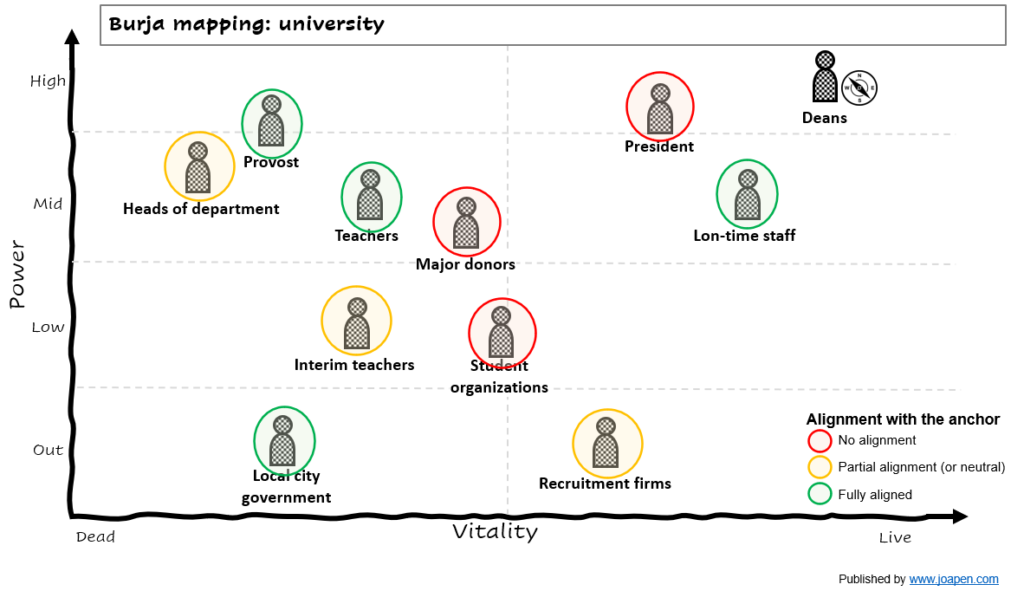What is it?
It’s a stakeholder analysis tool where power, vitality and alignment is being considered.
It’s not a replacement of Wardley Maps, it’s a complement to Wardley Maps.
All concepts around a Burja map happens thanks to the Empire Theory, and the consideration of power. So let’s start with it.
Empire theory
Empire Theory is a framework for understanding and practicing competitive strategy.
An empire is a group of coordinated actors that operate around some central power. Empires might be composed of players, resources, and other empires (sub-empires).
Empire Theory as one way to understand power:
Domain of competition
government, business, sport, music…
Power class
- High is the central power that defines an empire’s zone of coordination. It plays the largest role in determining the distribution of resources within the empire.
- Mid are individuals or groups that have sufficient power to challenge high’s control. Mid players will often have smaller empires of their own.
- Low are individuals or groups that can challenge mid but cannot challenge high. Low has the largest population and the least power.
- Outside is any actor that is not coordinated by the high power.
Vitality
- A live player is a person or group of people that is able to do things they have not done before.
- A dead player is a person or group of people that is working off a script, incapable of doing new things.
Alignment
Represent the concordance and discordance of direction between groups and the anchor. Here the anchor can be “you”, the component with highest power or other component you want to analyze.
As in stakeholder management, it’s important to understand which stakeholders are aligned with the anchor. In Burja map, you simplify the alignment by colors:
- Green: high alignment with anchor’s purpose (allies)
- Yellow: partial alignment with anchor’s purpose (to be defined or neutral position)
- Red: low alignment with anchor’s purpose (enemies).
We can add more layers on this classification, for instance:

To go deep in an analysis of power is key to focus on the interactions of power. It’s different the interactions between high-high entities than high-low entities. The different shapes on this type of relationships are very different in nature and in impact.
“Power can be used to accomplish a very broad range of goals. As such, many kinds of actors will aim to acquire power in the pursuit of their goals. The more effective they are and the better their understanding of reality is, the likelier they are to seek power.
Samo Burja
Origin of Burja maps
Samo Burja is a sociologist and the founder of Bismarck Analysis, which analyzes institutions, from governments to companies.
Amongst other things, Samo Burja has developed Empire Theory, “a framework for understanding and practicing competitive strategy”.
By combining Empire Theory with mapping, we can assess people and organizations in terms of power, and also evaluate possible strategic plays.
Focus: What + Who
Burja mapping introduce themselves as an extra analysis tool where they coexist with Wardley Maps.
A Wardley Map defines the context (what) and the Burja Map defines the dynamics between relevant players (Who).
Burja Map (stakeholder analysis)
Maps has to have each of these six components: be visual, have context, position has meaning, have an anchor, represent movement, and show components. Burja maps have these 6 characteristics:
- Burja maps are visual.
- They have a specific context (the empire),a specific team, organization, company…
- They have a position (High, Mid, Low, or Out), relative to the highest power class.
- They have an anchor: it could be “you” (alignment), the highest power (power) or the best practices (vitality).
- They have at least three forms of movement: power, vitality, and alignment (alliance and competition).
- They have specific types of components: an empire, player, or resource.
Anchor and movement are linked. There are three forms of movement, each with a separate anchor:
- Power (highest power in scope).
- Alignment (you, or a given player).
- Vitality (best practices).

